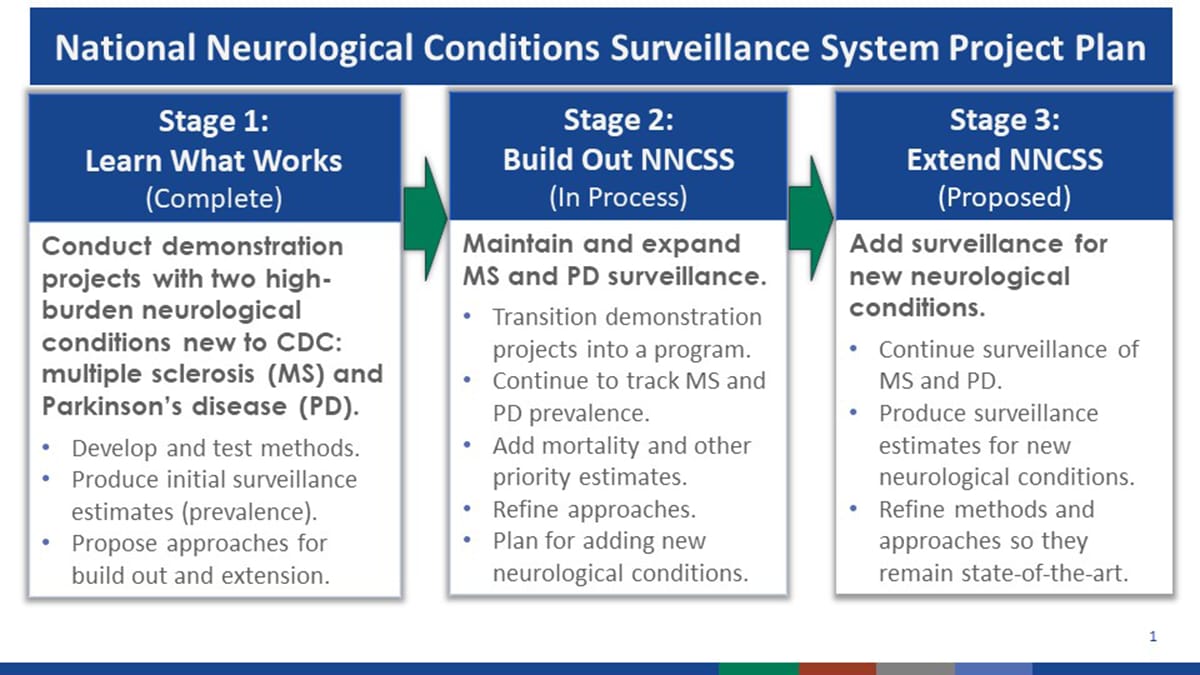What to know

Overview
Neurological disorders and conditions have substantial and sometimes devastating effects on millions of Americans of all ages. Congress therefore authorized Centers for Disease Control and Prevention (CDC) to develop the National Neurological Conditions Surveillance System (NNCSS).
- NNCSS was authorized in 2016, as part of the 21st Century Cures Act.
- CDC has received annual appropriated funds for NNCSS since fiscal year 2019.
NNCSS uses state-of-the-art data sources, tools, and methods to track the epidemiology of neurological conditions. NNCSS's aim is to produce actionable and timely information to
- Increase understanding of neurological conditions.
- Stimulate research into causes, diagnosis, and treatment.
Surveillance
Public health surveillance is the continuous, systematic collection, analysis, and interpretation of health-related data needed for public health practice. It should be linked with timely distribution of information to those who need to know and act upon the information.
Why NNCSS is Important
Focused surveillance enables CDC to estimate and track:
- Prevalence (number of people with various neurological conditions).
- Mortality (number of deaths) from neurological conditions.
- If prevalence, mortality, and incidence vary by
- Demographics (e.g., age, sex, race/ethnicity).
- Geography (e.g., region, state).
- Other factors (e.g., presence of other diseases).
Through sharing this information, CDC can strengthen partner collaboration to address identified needs.
Ultimately, NNCSS will
- Increase understanding of neurological conditions.
- Catalyze research into causes, diagnosis, and treatment.
- Inform healthcare and public health practice.
- Help improve health outcomes for millions of people of all ages.
NNCSS Project Plan
CDC is developing NNCSS via a three-stage project plan. NNCSS is currently in Stage 2. Stage 3 is dependent upon resources.

Accessible version: National Neurological Conditions Surveillance System (NNCSS) Project Plan
Stage 1: Learn What Works (Complete)
Conduct demonstration projects with two high-burden neurological conditions new to CDC: multiple sclerosis (MS) and Parkinson's disease (PD).
- Develop and test methods.
- Produce initial surveillance estimates (prevalence).
- Propose approaches for buildout and extension.
Stage 2: Build Out NNCSS (In Process)
Maintain and expand MS and PD surveillance.
- Transition demonstration projects into a program.
- Continue to track MS and PD prevalence.
- Add mortality and other priority surveillance estimates.
- Refine approaches.
- Plan for adding new neurological conditions.
Stage 3: Extend NNCSS (Proposed)
Add surveillance for new neurological conditions.
- Continue surveillance of MS and PD.
- Produce surveillance estimates for new neurological conditions.
- Refine methods and approaches so they remain state-of-the-art.
Why MS and PD Were First
MS and PD were chosen for demonstration projects because of their similarities and differences.
- Both affect many people and place a substantial burden on patients and their caregivers and families.
- Both have engaged patient advocacy groups.
Differences between them required CDC to test different methods and data sources. This makes NNCSS's approaches relevant to more neurological conditions. For example,
- PD is usually diagnosed at older ages (generally 60+). Data sources like Medicare claims may be useful for PD.
- MS is typically diagnosed between ages 20 – 40. Medicare claims will be less useful for MS.
- PD is very difficult to diagnose and has symptoms that overlap with other conditions. This makes it hard to determine which people have PD.
- Diagnostic criteria for MS are relatively clear. This makes it easier to identify who has MS.
How it Works: NNCSS Logic Model
NNCSS's logic model shows components of NNCSS's work and the relationships and flow between them to achieve meaningful outcomes.

